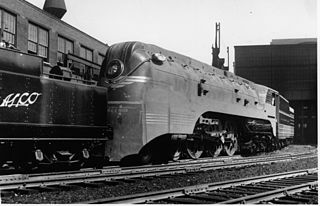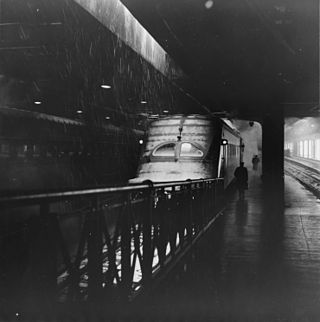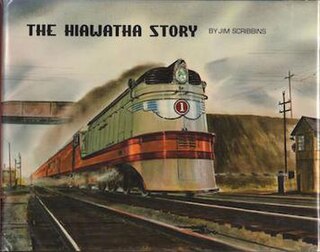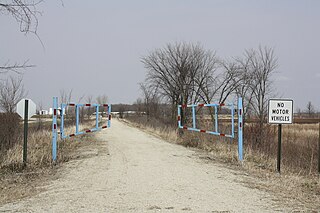
Iron Mountain is a city in and the county seat of Dickinson County, Michigan. The population was 7,518 at the 2020 census, down from 7,624 at the 2010 census. Located in the state's Upper Peninsula, Iron Mountain was named for the valuable iron ore found in the vicinity.

The Chicago, Milwaukee, St. Paul and Pacific Railroad (ACMStP&P), better known as the Milwaukee Road, was a Class I railroad that operated in the Midwest and Northwest of the United States from 1847 until 1986.

The Hiawatha, is an 86-mile (138 km) train route operated by Amtrak between Chicago, Illinois, and Milwaukee, Wisconsin. As of 2007, twelve to fourteen trains ran daily between Chicago and Milwaukee, making intermediate stops in Glenview, Illinois; Sturtevant, Wisconsin; and Milwaukee Mitchell International Airport. The line is partially supported by funding from the state governments of Wisconsin and Illinois. The line utilizes the CPKC Railway's C&M Subdivision and Metra's Milwaukee District North Line.

The Hiawathas were a fleet of named passenger trains operated by the Chicago, Milwaukee, St. Paul and Pacific Railroad between Chicago and various destinations in the Midwest and Western United States. The most notable of these trains was the original Twin Cities Hiawatha, which served the Twin Cities in Minnesota. The train was named for the epic poem The Song of Hiawatha by Henry Wadsworth Longfellow. The current Amtrak Hiawatha train is directly descended from the Milwaukee Road trains.

The 400 was a named passenger train operated by the Chicago and North Western Railway between Chicago and Saint Paul, with a final stop in Minneapolis. The train took its name from the schedule of 400 miles between the cities in 400 minutes, and was also a nod to "The Four Hundred Club", a term coined by Ward McAllister to refer to the social elite of New York City in the late 19th century. It was an express train with limited stops between Chicago and the Twin Cities. The "400" ran from 1935 to 1963 on the Chicago to Twin Cities route. The C&NW later named their other passenger trains using the number "400".

The Olympian and its successor the Olympian Hiawatha were passenger trains operated by the Chicago, Milwaukee, St. Paul and Pacific Railroad between Chicago and the Pacific Northwest. The Olympian operated from 1911 to 1947 and was, along with its running mate the Columbian, the first all-steel train to operate in the Pacific Northwest. The streamlined Olympian Hiawatha operated from 1947 to 1961 and was one of several Milwaukee Road trains to carry the name "Hiawatha". The Olympian Hiawatha was designed by industrial designer Brooks Stevens and included the distinctive glassed-in "Skytop" observation-sleeping cars. It later featured full-length "Super Dome" cars.

The Milwaukee Road's class "F7" comprised six (#100–#105) high-speed, streamlined 4-6-4 "Baltic" (Hudson) type steam locomotives built by the American Locomotive Company (ALCO) in 1937–38 to haul the Milwaukee's Hiawatha express passenger trains. Following on from the success of the road's class "A" 4-4-2s, the F7s allowed the road to haul heavier trains on the popular Chicago–Twin Cities routes.

The Columbian was a named passenger train operated by the Chicago, Milwaukee, St. Paul and Pacific Railroad between Chicago, Illinois, and Seattle/Tacoma, Washington. The westbound train was Milwaukee Road train #17, and the eastbound train was train #18. It was launched on Monday, May 29, 1911. The same day, the faster, limited-stop and more luxurious Olympian also launched. These were the first passenger trains to take advantage of the Milwaukee Road Pacific Extension, which had opened to freight in 1909.
The Fast Mail was a train service operated by the Chicago, Milwaukee, St. Paul and Pacific Railroad on an overnight schedule between Chicago, Illinois, and Minneapolis, Minnesota. The southbound trains were Milwaukee Road train Nos. 56 and 58, and the northbound trains were train Nos. 55 and 57. In its early years, this train service helped earn the Milwaukee Road's line the nickname "The Fast Mail Line." In 1924, the Fast Mail was the target of the largest train robbery in U.S. history. The Fast Mail was discontinued with train 56's arrival in Chicago on May 1, 1971.

The Twin Cities Hiawatha, often just Hiawatha, was a named passenger train operated by the Chicago, Milwaukee, St. Paul and Pacific Railroad, and traveled from Chicago to the Twin Cities. The original train takes its name from the epic poem The Song of Hiawatha by Henry Wadsworth Longfellow. There are a number of Hiawatha-themed names within the city of Minneapolis, the terminus of the original train. The first Hiawatha ran in 1935; in 1939 the Milwaukee Road introduced a second daily trip between Chicago and Minneapolis. The two trains were known as the Morning Hiawatha and Afternoon Hiawatha, or sometimes the AM Twin Cities Hiawatha and PM Twin Cities Hiawatha. The Milwaukee Road discontinued the Afternoon Hiawatha in 1970 while the Morning Hiawatha continued running until the formation of Amtrak in 1971.

The Escanaba & Lake Superior Railroad is a Class III shortline railroad that operates 347 miles (558 km) of track in Northeastern Wisconsin and the Upper Peninsula of Michigan. Its main line runs 208 miles (335 km) from Rockland, Michigan, to Green Bay, Wisconsin, and it also owns various branch lines and out-of-service track. In 1897, the Escanaba River Company built a seven-mile (11 km) railroad from Wells, Michigan, to tap a large hardwood timber stand at LaFave’s Hill. In 1898, the company name was changed to the Escanaba & Lake Superior Railway (E&LS).

The Peninsula 400 was a daily express passenger train operated by the Chicago and North Western Railway between Chicago and Ishpeming, in Michigan's Upper Peninsula. It operated as a named consist from 1942 to 1969. It was one of the railroad's 400 passenger trains, whose name stemmed from the original '400-mile, 400-minute' express operated by the railroad between Chicago and Minneapolis–St. Paul.

The North Woods Hiawatha was a streamlined passenger train operated by the Chicago, Milwaukee, St. Paul and Pacific Railroad between New Lisbon and Minocqua, Wisconsin. It operated from 1936 until 1956. The North Woods Hiawatha was the first new route to adopt the Hiawatha brand.

The Skytop Lounges were a fleet of streamlined passenger cars with parlor-lounge cars built by the Chicago, Milwaukee, St. Paul and Pacific Railroad and sleeper-lounges built by Pullman-Standard in 1948. The cars were designed by famed industrial designer Brooks Stevens. The fleet included both parlor-lounges and sleeping cars. The lounges entered service in 1948 on the Twin Cities Hiawatha, while the sleeping cars were used on the long-distance Olympian Hiawatha. In 1964 the Milwaukee Road sold the sleeping cars to the Canadian National Railway, which operated them until 1977. The parlor cars continued in service with the Milwaukee Road until 1970, when they were retired.

The Beaver Tails were a fleet of streamlined parlor-observation passenger cars built by the Chicago, Milwaukee, St. Paul and Pacific Railroad between 1934–1938. They served as the observation cars on the famous Hiawatha trains from 1935 until 1948, when they were displaced by the new Skytop Lounge. The cars' name was derived from the distinctive flat, sloped rear of the car.

The Copper Country Limited was a passenger train operated by the Chicago, Milwaukee, St. Paul and Pacific Railroad and the Duluth, South Shore and Atlantic Railway (DSS&A) between Chicago, Illinois and Calumet, Michigan, in Michigan's Upper Peninsula. It operated from 1907 to 1968.
The El Camino was a set of lightweight streamlined railcars owned by Los Angeles County in the 1970s and 1980s. The county acquired the cars to bootstrap a proposed commuter rail service between Los Angeles and Orange County. This effort, spearheaded by County Supervisor Baxter Ward, was unsuccessful. The equipment saw limited use on Amtrak's San Diegan in 1978 and was sold in 1985.

The Hiawatha Story is a 1970 non-fiction book on railroad history by Jim Scribbins, then an employee of the Chicago, Milwaukee, St. Paul and Pacific Railroad. The book covers the history of the Milwaukee Road's most famous passenger train, the Hiawatha, from its creation in 1934–1935 up through 1970. The book also covered the various other Milwaukee Road trains which carried the name "Hiawatha."

The Milwaukee and Northern Railway Company (M&N) is a former railroad company that built a railroad connecting Milwaukee, Green Bay, and Michigan's Upper Peninsula.

The Cannonball was a commuter rail train operated by the Milwaukee Road from Watertown to Milwaukee, Wisconsin, United States, until 1972. It was the last commuter train to serve Milwaukee. Cannonball was a colloquial nickname for the train, which operated as Train No. 12 inbound in the morning and No. 23 outbound in the evening.



















